Australian dollar Encountered hurdles as the US dollar Strengthened amid market caution.
On Wednesday, the Australian Dollar (AUD) aims to end a losing trend by Stabilizing against the US Dollar (USD). In the previous session, the AUDUSD pair fell due to a Stronger Greenback and higher US Treasury yields. Market participants have lowered speculation on rates. cutbacks by the US Federal Reserve (Fed). Investors are also being cautious due to increased tensions in the Middle East conflict. Furthermore, a drop in commodity prices, possibly indicating concerns about reduced demand from China, has weighed on the Australian dollar (AUD).
Australian central bank is anticipated to refrain from raising interest rates, prompted by lower consumer confidence in January.
Australia’s Consumer Confidence data for January fell, adding to speculation that the Reserve Bank of Australia (RBA) will not tighten policy further at its upcoming board meeting in February. This notion, in turn, is exerting pressure on the AUDUSD rate.
China’s yearly GDP increased by 5.2%, slightly less than the 5.3% forecast for the fourth quarter.
China’s yearly GDP increased by 5.2%, compared to the 5.3% projected in the fourth quarter. Industrial production in December increased by 6.8% year on year. which was predicted to be steady at 6.6%. Retail sales year over year Came in at 7.4%, falling shy of the market consensus of 8.0%.
The drop in commodity prices contributed to downward pressure on the AUD.
In December, Chinese consumer prices fell for the third month in a row, as did producer prices. This shows that the country is experiencing ongoing deflationary cost pressures. However, in a speech delivered on Tuesday at the World Economic Forum in Davos, Premier Li Qiang stated that China’s economy will grow by roughly 5.2% in 2023. This growth rate is somewhat over the stated objective established by Beijing.
Upbeat US Treasury yields helped to strengthen the greenback.
The US Dollar Index (DXY) is holding steady after a four-day gaining streak, bolstered by recent comments from Federal Reserve officials. Fed Governor Christopher Waller warned that, despite encouraging developments in the inflation forecast, the central bank is not rushing to announce rate decreases.
Atlanta Fed President Raphael Bostic also cautioned over the weekend that premature interest rate decreases could cause inflationary pressures. Bostic noted that the central bank’s slowing of inflation toward its 2.0% target is projected to decelerate in the coming months.
The US NY Empire State Manufacturing Index fell to 43.7 in January, considerably below the predicted decrease of 5. Traders are expected to keep an eye on the impending US Retail Sales data for December. Retail sales are expected to expand slightly, providing insight into consumer spending trends.
Daily Market Movers: The Australian dollar falls on Improved US dollar.
Australian TD Securities Inflation jumped by 5.2% year on year in December, up from 4.4% in November.
Australia’s job adverts Increased by 0.1% in









